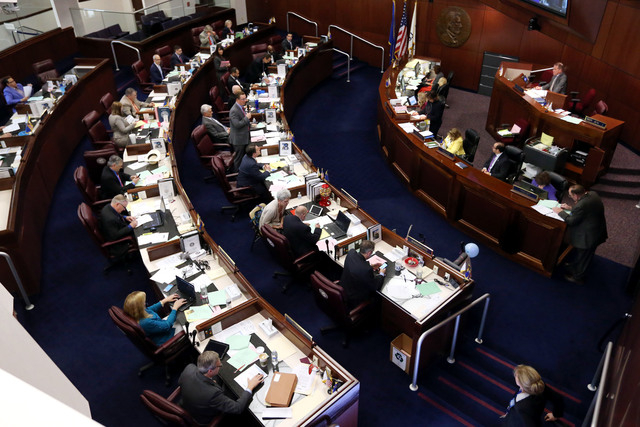Next up: Unintended consequences of 2015 legislative session

The 2015 Legislature is over. Now we wait for the unintended consequences to creep out of the ooze like a crocodile looking for a bite-sized child.
We didn’t have to wait for the name-calling; that began while the Legislature was still in session. GOP legislators who refused to cling to dogma and actually (horror of horrors!) changed their minds and (horror of horrors!) followed the GOP governor’s lead to raise taxes were tagged with the contemptuous RINO — Republican in Name Only.
The reality is, when bills are rushed through at the end, and sometimes even before, there are unintended consequences.
Sen. Tick Segerblom’s 2013 medical marijuana dispensary bill is a case in point. There were so many problems with Senate Bill 374 two years ago that local and state governments couldn’t readily sort out the conflicts and confusion. And medical marijuana establishments are not yet available two years later in Nevada.
Segerblom didn’t intend the mess that emerged from his bill, so it falls under the category of unintended consequences. His 2015 medical marijuana dispensary cleanup bill, SB276, is now awaiting the governor’s signature. (His medical pot for pets bill, SB372, whimpered to an early demise without a hearing.)
Some bills may be discovered to have consequences that were intended — by lobbyists. With this particular Legislature, with so many inexperienced lawmakers lacking government experience of any kind, clever phrasing is likely to end up tricking some. Add that to the bills that certain lawmakers didn’t read before they voted, or perhaps didn’t understand if they did read it, and that created more unintended consequences. Or consequences that a clever attorney can use for an advantage.
I can’t remember the number of times I’ve read legal documents asking one essential question: What was the legislative intent? And it wasn’t clear from the record. Not the minutes, not even the bill itself. Often the Nevada Supreme Court must wrestle with this question.
The Supremes aren’t above engaging in legislative hanky panky.
Nevada Appeal reporter Geoff Dornan discovered some judicial gamesmanship. When the three-person appellate panel was passed in 1997, it included language saying the seven-person Supreme Court would drop from seven to five justices.
But, as Dornan pointed out, on Day 119 of the 120-day session, language was put into the appropriation bill, repealing the 1997 “savings” of about $500,000 for the two justices and their staffs.
There will still be seven justices’ jobs, three appellate justices and no savings.
I don’t have a problem with that; I have a problem with how it was handled. The sneak factor.
The hope was that it wouldn’t be noticed. Finance Chairman Ben Kieckhefer, R-Reno, told Dornan, “We did nothing illegal.”
No one said you did, but the way it was handled certainly fell way outside the realm of transparency. It was underhanded.
The majority of bills already signed into law failed to get extensive attention because, rightfully so, the controversial bills and the budget bills, and the education package soaked up much of the coverage.
Yet the bills with less scrutiny may impact you, your business or your family. It’s worth it to click on this link and check out whether a bill changes something that interests you: https://www.leg.state.nv.us/Session/78th2015/Reports/governor.cfm
Plenty of bills that received extensive news media attention went nowhere. Assembly Bill 405, the bill requiring that parents be notified if their underage daughter seeks an abortion, died. So did “campus carry,” allowing students to pack heat on college and university campuses, if they had concealed weapons permit.
Then there are the bills Gov. Brian Sandoval might veto. Here’s that link: https://www.leg.state.nv.us/Session/78th2015/Reports/vetoed.cfm
He hasn’t vetoed any 2015 bills yet. But he has 10 days after the session ends, excluding Sunday, so June 12 is his last day to veto.
Sandoval isn’t shy about using his veto power.
In 2013, he vetoed 17 bills, including the highly controversial one involving NV Energy, AB391, advocated by his close advisers.
In 2011, he vetoed 18 bills.
So, the game is still afoot for those struggling to kill bills. At this point, there is no resurrection, the only action left is to kill a bill through the governor’s veto. The bill that seems the most vulnerable to death by veto at this point is the one to plan splitting the Clark County School District into five districts, AB394.
Is there any wonder a murder mystery set in the Nevada Legislature is just one of my novel ideas? Maybe with a subplot involving the Nevada Supreme Court.
Jane Ann Morrison’s column appears Thursdays. Email her at jmorrison@reviewjournal.com or leave a message at 702-383-0275. Find her on Twitter: @janeannmorrison